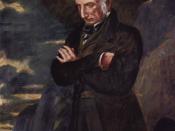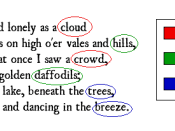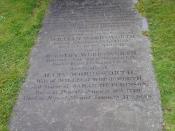Analysis And Comparison Of Two Sonnets How Soon Hath Time, by John Milton, and Mutability, by William Wordsworth are two excellent examples of a well-written sonnet. They have their similarities between one another, and also their differences. In the end, however, each is a quality piece of literature.
How Soon Hath Time has a rhyme scheme of "ÃÂa, b, b, a, a, b, b, a, c, d, e, d, c, e'. Therefore, this is a Petrarchan sonnet. The syntax of this sonnet is very regular. There are major punctuation marks after the fourth and eight lines, in this case periods. These periods effectively divide the octet into two equal quatrains. The sestet is then divided into two sections, the first one being four lines long, followed by a colon. After the colon are the last two lines, concluding both the poem and the sestet. The meter of this poem is also quite regular, it has a smooth rhythm, and flows out of the mouth nicely, for example "How soon hath Time, the subtle thief of youth"ÃÂ (accented syllables in italics).
This poem is about Life, and Death. It is about how time affects out lives, in particular the life of the author, John Milton. I believe that this poem is partly about how fast time goes by, without us ever fully realizing it. A quote that reinforces this belief is "How soon hath Time, the subtle thief of youth, / Stol'n on his wing my three-and-twentieth year!"ÃÂ. There is also the theme of "ÃÂTime the destroyer' in this poem, a fairly common theme for sonnets from this era. John Milton reinforces this by personifying time, by capitalizing the "ÃÂT'.
This poem also refers to how inevitable death is. A quote that reinforces this is "Yet it be less or more, or soon or slow"æ"æ.Toward which Time leads me, and the will of Heav'n"ÃÂ. Overall, this is an interesting sonnet, to say the least. It definitely got me thinking about its meaning, which I think was the author's intent.
Mutability has a rhyme scheme of "ÃÂa, b, b, a, a, c, c, a, d, a, c, d, c, a'. Therefore, it is a Petrarchan sonnet, although somewhat different than the rhyme scheme of How Soon Hath Time. The syntax of this sonnet is very irregular, it does not fit the typical structure of a petrarchan sonnet. The first major punctuation break comes at the end of the third line, in the form of a semi-colon. The second major punctuation break comes at the end of the sixth line, in the form of a period. Therefore, this sonnet begins with its sestet, instead of its octet. The octet is divided into two sections by the semi-colon in the middle of the tenth line. However, it's not divided equally, it's divided into one that is three and a half lines long, and one that is four and a half lines long. The meter in this poem is fairly normal, with no major irregularities.
This poem is about how all things are affected by the chaos in this world. It goes through the different things of this planet that are affected by chaos, including humans, Truth, and Time. The quotes to support this are "From low to high doth dissolution climb"ÃÂ, "Truth fails not; but her outward forms that bear the longest date do melt like frosty rime"ÃÂ and "Some casual shout that broke the silent air, Or the unimaginable touch of Time."ÃÂ. The broader theme is that bad things affect everything.
These are two quality sonnets, and have their similarities and differences. They are similar in that they are both Petrarchan sonnets, with a similar rhyme scheme. They are also similar in that the meter is relatively regular in both of them. They are also similar in that they both have an octet and a sestet, although they are arranged in a different order. One important theme that I believe they have in common is that they both involve in something being destroyed. In How Soon Hath Time, it is life itself that is slowly being destroyed by time. In Mutability, it is everything that is essentially being destroyed by chaos.
These two sonnets also have their differences. For example, the arrangement of the octets and sestets is different between the two. Also, the themes are different in that the "ÃÂdestroyer' and the "ÃÂdestroyees' are different. The syntax in Mutability is also much different than it is in How Soon Hath Time. The syntax in Mutability is much more irregular. Although these sonnets do have their differences, they are both great in that they capture the readers' attention, and make the reader think. John Milton and William Wordsworth both obviously knew what they were doing.





